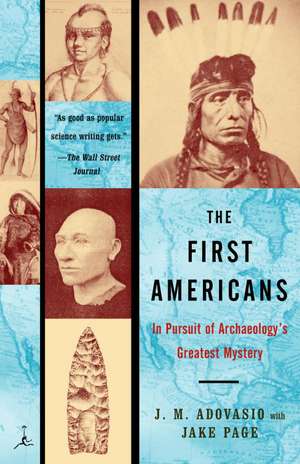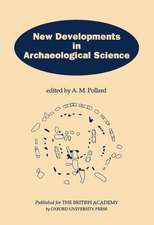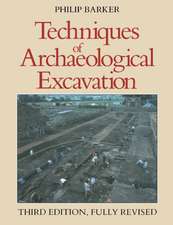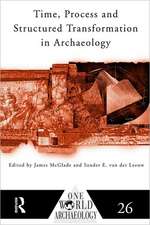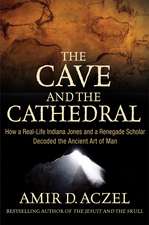The First Americans: In Pursuit of Archaeology's Greatest Mystery: Modern Library Paperbacks
Autor James Adovasio, J. M. Adovasio Jake Pageen Limba Engleză Paperback – 31 mai 2003
At its heart, The First Americans is the story of the revolution in thinking that Adovasio and his fellow archaeologists have brought about, and the firestorm it has ignited. As he writes, “The work of lifetimes has been put at risk, reputations have been damaged, an astounding amount of silliness and even profound stupidity has been taken as serious thought, and always lurking in the background of all the argumentation and gnashing of tenets has been the question of whether the field of archaeology can ever be pursued as a science.”
Preț: 137.94 lei
Nou
Puncte Express: 207
Preț estimativ în valută:
26.40€ • 28.69$ • 22.19£
26.40€ • 28.69$ • 22.19£
Carte disponibilă
Livrare economică 31 martie-14 aprilie
Preluare comenzi: 021 569.72.76
Specificații
ISBN-13: 9780375757044
ISBN-10: 037575704X
Pagini: 352
Ilustrații: 87 B&W PHOTOS AND ILLUS
Dimensiuni: 132 x 201 x 18 mm
Greutate: 0.36 kg
Editura: Modern Library
Seria Modern Library Paperbacks
ISBN-10: 037575704X
Pagini: 352
Ilustrații: 87 B&W PHOTOS AND ILLUS
Dimensiuni: 132 x 201 x 18 mm
Greutate: 0.36 kg
Editura: Modern Library
Seria Modern Library Paperbacks
Notă biografică
J. M. Adovasio, Ph.D., is the founder and director of the Mercyhurst Archaeological Institute. He lives near Erie, Pennsylvania.
Jake Page is a former editor of Natural History magazine and science editor of Smithsonian magazine. He lives in Corrales, New Mexico.
Jake Page is a former editor of Natural History magazine and science editor of Smithsonian magazine. He lives in Corrales, New Mexico.
Extras
CHAPTER ONE
GLIMPSES THROUGH THE LOOKING GLASS
When Christopher Columbus first slogged ashore on October 12, 1492, on either the Caribbean island of San Salvador or Samana Cay, he was met by Arawak-speaking people who called themselves Taino and who apparently made an excellent first impression. "They are affectionate people," Columbus reported, "and without covetousness and apt for anything, which I certify." He went on to write, "I believe there is no better people or land in the world. They love their neighbors as themselves and have the sweetest speech in the world and gentle, and are always smiling." Not knowing who these seemingly happy-go-lucky folk were, Columbus imagined them to be Asians-perhaps Hindus or Spice Islanders. Yet, despite his boosterism, he was disappointed to find these natives less advanced than he expected of Asians. In fact, the Tainos were fairly sophisticated agriculturalists living in villages of a thousand or more, each with up to fifty round, conical-roofed houses of wood and thatch ringed around a plaza and presided over by a chieftain. The villages were organized into district chiefdoms; two social strata, nobles and commoners, existed; and local artisans worked in wood, ceramics, weaving, and other crafts, including gold imported from mainland South America. Even so, they were hardly what might be expected by someone who had read about Marco Polo's travels to the Orient.
Soon the neighbor-loving Tainos made it plain that their particular neighbors, known as Caribs and located to the south in what we call the Virgin Islands, were cannibals bent on wiping out the Tainos. Here we have an early version of two of the longest-running stereotypes about the native peoples of America-the noble savage and the bloodthirsty barbarian. Before many more years passed, both the Tainos and the Caribs (who were probably innocent of cannibalism) were largely extinct, victims of European diseases, the vicissitudes of Spanish enslavement, and outright murder. But untold millions of other native peoples awaited the Europeans in the New World, and once it became clear that this was not Asia, the questions soon arose: Who the hell are these people, where did they come from, and when did they get here? Even after the passage of more than five hundred years, the answers to these simple questions remain somewhat imprecise.
Early on, some Europeans wondered if the native populations of the New World were actually people-humans, as Europeans defined the word. This was in spite of the fact that by 1510 Cortés had encountered the Aztec empire and entered its capital, Tenochtitlán, a vast city grander and more beautiful, by accounts, than anything in contemporary Europe. The Spanish thus had an early realization of the breadth of cultural diversity to be found in the New World, but even the Aztecs, with their own version of high society, did not fit well into the pigeonholes of European preconceptions. And it was only a few years after the Spanish arrival that even the Aztecs and Incas were reduced to peonage, their civilizations effectively razed.
At the time, maps of much of the world outside Europe still reported that "there be monsters here," and stories abounded of creatures on distant shores who were part human, part animal. Unicorns could still appear to those whose lives had been perfectly meritorious, and as late as the next century an English adventurer, Martin Frobisher, would return from an Arctic voyage with tales of gold and with the single horn of what he believed to be a sea unicorn (an object we know as a narwhal tusk), which he presented to Queen Elizabeth. Coming upon the shores of America, one might imagine, then, that creatures with so little by way of the trappings of civilization were people, yes, but people without souls, just as animals were without souls.
Paracelsus, the brilliant sixteenth-century Swiss physician who is often thought of as the father of chemical medicine, believed that the aboriginal Americans were not "of the posterity of Adam and Eve" but had been created separately and were without souls. The matter would continue to be debated for the remainder of the century by Spanish philosophers and papal theologians. Generally speaking, the men of the Church took the most benign view of the Indians, believing that the pope's benevolent sway should be extended over the natives' lives in order to save their souls. (At the outset, Columbus commented that the Arawaks' easygoing nature made them excellent candidates for enslavement, and the Spanish colonists saw them all as little more than useful chattels.) Some theologians cited Aristotle's Politics to the effect that many people were born to be ruled over, and the Native Americans, having no "written laws, but barbaric institutions and customs," were among them-meaning that they could be enslaved or killed in order to bring them to Christ (in the afterlife). People on the ground, however, typically took an even less benign view. Amerigo Vespucci, sailing for the Portuguese, found the natives of South America to be hardly more than brutes, as well as worshipers of the Devil, given to cannibalism and other amoralities. Later, a Dominican missionary, Tomás Ortiz, perhaps by way of explaining the difficulty of his holy task, wrote the following description:
On the mainland they eat human flesh. They are more given to sodomy than any other nation. There is no justice among them. They go naked. They have no respect either for love or for virginity. They are stupid and silly. They have no respect for truth, save when it is to their advantage. . . . Most hostile to religion, dishonest, abject, and vile, in their judgements they keep no faith or law. . . . I may therefore affirm that God has never created a race more full of vice and composed without the least mixture of kindness or culture. . . . We here speak of those whom we know by experience. Especially the father, Pedro de Córdoba, who has sent me these facts in writing . . . the Indians are more stupid than asses and refuse to improve in anything.
Depressingly enough, sentiments very much like these were heard throughout the ensuing centuries, even to the present. On the other hand, the Native Americans had their early champions as well, none more vigorous and devoted than the Spanish Fray Bartolomé de Las Casas, who argued eloquently for the rights of the natives. He claimed that the pope had no temporal or coercive power over the native populations, that the gospel should be preached to them but only peacefully, and that the conquistadors' claims on the Indians' land and persons were illegal. He saw all people, including the Native Americans, as humans in various stages of cultural development and thought the natives of the New World were probably quite ancient. Las Casas had a good deal of influence on the powers back home, as did another cleric, the Dominican Bernardino de Minaya. Minaya deserted Pizarro in disgust and went to Rome to persuade Pope Paul III to issue a papal bull in 1537 that rejected the idea of Indians as mere brutes and declared them capable and desirous of embracing the Catholic faith. Not only that, the bull proclaimed, even those Native Americans who chose not to follow Christ were not to be enslaved or have their property taken. This was too much. Bristling with secular outrage, Emperor Charles ordered all copies of the bull confiscated and prevailed on the pope to rescind the bull altogether. For his efforts Minaya was thrown into jail by the head of his order.
Even as late as 1590, one sympathetic Spanish Jesuit missionary in Peru, José de Acosta, felt the need to denounce the "common opinion" that the natives of the New World were mere brutes without reason. They were barbarians-meaning non-Christian-to be sure, and Acosta attempted to put all barbarians into one of three categories. First were peoples such as the Japanese and Chinese, who had permanent governments, cities, commerce, and writing. This class of barbarians was to be proselytized to and converted to Christianity without force. Second were those such as the Aztecs and Incas, who were without writing but enjoyed permanent governments and recognizably religious ceremonies. If such peoples-so far from what he called "right reason"-were not put under Christian rule and ordered to become Christian, they probably could not be converted and thus would remain barbarians. The third class of barbarians was free-roaming savages, without government, laws, or fixed settlements. They were the people of whom Aristotle had spoken-who deserved to be enslaved-and, like the Caribs, they needed to be forced to accept Christianity or suffer the consequences. Of course, this all led to a philosophical conundrum: If an illiterate barbarian-a savage, say-were converted to the Cross, was he still a barbarian? Could there be such a thing as a Christian barbarian?
Interestingly, many of the early European explorers and adventurers noticed the similarity in appearance between the Indians and Asians. De Acosta took this a step further, suggesting that the Americas had been populated by a slow overland migration from Asia, perhaps as early as two thousand years before the arrival of the Spaniards. This was an astonishing insight, considering that no European had even come close to the Bering Sea or had any notion of the configuration of the lands to the north. Indeed, on maps of the time, the whole area from northeast Asia to the Urals was called simply Tartary. By 1648, the Englishman Thomas Gage had posited the Bering Strait area as the region crossed by Mongolian-type people-a path that would become a certainty only in the next century, when Vitus Bering, a Dane sailing in behalf of the Russian czar, discovered the strait that bears his name.
As for the early Spanish soldiers and settlers, if they intended to enslave the native people of the New World whenever they were needed (and that was indeed their intent), and if they sought justification (which they rarely did), Aristotle's pronouncement about people born to be subjugated was moral balm. Even more convenient was the word of Saint Augustine, who, in the fifth century, had first enunciated the Christian notion of a just war: one waged to right an injustice or wrong by another nation, one such wrong being (by implication) not being Christian. Any refusal by the barbarians of the New World to let a missionary preach or to let a Spaniard "sojourn" among them could now be construed as sufficient cause to launch a just attack.
To sojourn meant to trade, in fact, and the right of men to do commerce anywhere in the world was soon added to the mandate to promulgate the Cross as a justification for war shared by all the European nations in the New World. When Native Americans stood in the way of what we now think of as free trade, they became mere impediments to be shoved aside or eliminated. This was especially true of the British colonists, who had little interest in converting the natives to their own versions of Christianity. With a few notable exceptions, such as William Penn and, to an extent, the clergyman Roger Williams, the British were mainly intent on taking over as much land as they could and removing the aboriginal inhabitants from it as quickly as possible.
Even the French-many of whom were (like the Spanish) given to intermarrying with the natives and (unlike the Spanish) adapting to their ways-initially had trouble even seeing them accurately. One of the earliest representations of American natives appeared among the decorations on a French map of 1613, an engraving based on drawings by Samuel de Champlain himself. Along with such identifiable local fruits as hickory nuts, plums, and summer squash is a "savage" couple evidently from Nova Scotia, then called Acadia. They both have feathers in their hair and earrings; the man holds a knife and an arrow in his hands, while the woman holds an ear of corn and a squash (neither was grown aboriginally in Nova Scotia). She wears only a loincloth and he what looks for all the world like a Speedo bathing suit. Both have wavy blond hair, European facial features, and the muscular calves and delicate feet of Renaissance art.
Most Europeans, whether botanists, artists, or philosophers, tried to fit all the astounding new finds from the New World into the classical schemes that informed the Renaissance-which, as art historian Hugh Honour has pointed out, were largely "wish-fulfillment dreams" of an Arcadian past that had never existed. For reasons not hard to imagine, early reports about the so-called Indians dwelled on the widespread nudity and what Europeans believed to be free love. (It was not uncommon for Europeans to be offered the use of women when they first arrived, as part of the gift giving typical of many American native cultures.) Those practices, plus the apparent absence of property and laws among the natives, reminded Europeans of their own imagined Golden Age. Even in the nineteenth century, European artists would still represent the New World allegorically as a naked woman wearing little but feathers.
Of course, there was the other side of all this: to begin with, the widespread reports of cannibalism, always a disruptive note in your classic Golden Age fantasy. Indeed, early on, Europeans developed a schizoid sense of America, most of them seeing its wonders only through the eyes of naturalists and other travelers (and in some cases through observing a few savages brought back to European courts as exotic talking booty).
Of all the continents coming under European scrutiny, North and South America were seen as probably the last to be inhabited and the last created-as the poet John Donne put it, "that unripe side of earth." There the mammal population had degenerated, as did Europeans who stayed too long. Some compared the natives to the fabled European wild men of the woods; in reports from the New World, Shakespeare found an inspiration for Caliban. The philosopher Thomas Hobbes was speaking about Native Americans when he wrote his famous dictum about the uncivilized, savage life being "solitary, poor, nasty, brutish and short."
Given even an artist's incapacity to see these people, it is no wonder that philosophers back home happily spun a bundle of assumptions and what today we would call stereotypes into grand theories about the aboriginal Americans, such overarching schemes as "the noble savage" and the "treacherous and murdering savage," both of which still haunt Native Americans, although the terms are a bit different today. We no longer have Rousseau's innocent, Edenic noble savage, given to purity of feeling as opposed to the degraded world of reason (which was a wondrous bit of condescension, no matter that it helped power the French Revolution). Instead, we have today's ecosaints, a race of people instinctually attuned to abiding on the land without leaving even the trace of a moccasin print, a race so spiritual that virtually every New Ager has linked up with a native shaman from one past life or another. On the other hand, gone are the no-good, bloodthirsty "redskins" who once marauded innocent sodbusters and did battle with John Wayne's blue-coated cavalry; we now have the no-good Indian incapable of a full day's work in his tribe's Mafia-controlled casino and instead typically found in a sodden stupor in the gutter of some squalid off-reservation town like Gallup, New Mexico.
From the Hardcover edition.
GLIMPSES THROUGH THE LOOKING GLASS
When Christopher Columbus first slogged ashore on October 12, 1492, on either the Caribbean island of San Salvador or Samana Cay, he was met by Arawak-speaking people who called themselves Taino and who apparently made an excellent first impression. "They are affectionate people," Columbus reported, "and without covetousness and apt for anything, which I certify." He went on to write, "I believe there is no better people or land in the world. They love their neighbors as themselves and have the sweetest speech in the world and gentle, and are always smiling." Not knowing who these seemingly happy-go-lucky folk were, Columbus imagined them to be Asians-perhaps Hindus or Spice Islanders. Yet, despite his boosterism, he was disappointed to find these natives less advanced than he expected of Asians. In fact, the Tainos were fairly sophisticated agriculturalists living in villages of a thousand or more, each with up to fifty round, conical-roofed houses of wood and thatch ringed around a plaza and presided over by a chieftain. The villages were organized into district chiefdoms; two social strata, nobles and commoners, existed; and local artisans worked in wood, ceramics, weaving, and other crafts, including gold imported from mainland South America. Even so, they were hardly what might be expected by someone who had read about Marco Polo's travels to the Orient.
Soon the neighbor-loving Tainos made it plain that their particular neighbors, known as Caribs and located to the south in what we call the Virgin Islands, were cannibals bent on wiping out the Tainos. Here we have an early version of two of the longest-running stereotypes about the native peoples of America-the noble savage and the bloodthirsty barbarian. Before many more years passed, both the Tainos and the Caribs (who were probably innocent of cannibalism) were largely extinct, victims of European diseases, the vicissitudes of Spanish enslavement, and outright murder. But untold millions of other native peoples awaited the Europeans in the New World, and once it became clear that this was not Asia, the questions soon arose: Who the hell are these people, where did they come from, and when did they get here? Even after the passage of more than five hundred years, the answers to these simple questions remain somewhat imprecise.
Early on, some Europeans wondered if the native populations of the New World were actually people-humans, as Europeans defined the word. This was in spite of the fact that by 1510 Cortés had encountered the Aztec empire and entered its capital, Tenochtitlán, a vast city grander and more beautiful, by accounts, than anything in contemporary Europe. The Spanish thus had an early realization of the breadth of cultural diversity to be found in the New World, but even the Aztecs, with their own version of high society, did not fit well into the pigeonholes of European preconceptions. And it was only a few years after the Spanish arrival that even the Aztecs and Incas were reduced to peonage, their civilizations effectively razed.
At the time, maps of much of the world outside Europe still reported that "there be monsters here," and stories abounded of creatures on distant shores who were part human, part animal. Unicorns could still appear to those whose lives had been perfectly meritorious, and as late as the next century an English adventurer, Martin Frobisher, would return from an Arctic voyage with tales of gold and with the single horn of what he believed to be a sea unicorn (an object we know as a narwhal tusk), which he presented to Queen Elizabeth. Coming upon the shores of America, one might imagine, then, that creatures with so little by way of the trappings of civilization were people, yes, but people without souls, just as animals were without souls.
Paracelsus, the brilliant sixteenth-century Swiss physician who is often thought of as the father of chemical medicine, believed that the aboriginal Americans were not "of the posterity of Adam and Eve" but had been created separately and were without souls. The matter would continue to be debated for the remainder of the century by Spanish philosophers and papal theologians. Generally speaking, the men of the Church took the most benign view of the Indians, believing that the pope's benevolent sway should be extended over the natives' lives in order to save their souls. (At the outset, Columbus commented that the Arawaks' easygoing nature made them excellent candidates for enslavement, and the Spanish colonists saw them all as little more than useful chattels.) Some theologians cited Aristotle's Politics to the effect that many people were born to be ruled over, and the Native Americans, having no "written laws, but barbaric institutions and customs," were among them-meaning that they could be enslaved or killed in order to bring them to Christ (in the afterlife). People on the ground, however, typically took an even less benign view. Amerigo Vespucci, sailing for the Portuguese, found the natives of South America to be hardly more than brutes, as well as worshipers of the Devil, given to cannibalism and other amoralities. Later, a Dominican missionary, Tomás Ortiz, perhaps by way of explaining the difficulty of his holy task, wrote the following description:
On the mainland they eat human flesh. They are more given to sodomy than any other nation. There is no justice among them. They go naked. They have no respect either for love or for virginity. They are stupid and silly. They have no respect for truth, save when it is to their advantage. . . . Most hostile to religion, dishonest, abject, and vile, in their judgements they keep no faith or law. . . . I may therefore affirm that God has never created a race more full of vice and composed without the least mixture of kindness or culture. . . . We here speak of those whom we know by experience. Especially the father, Pedro de Córdoba, who has sent me these facts in writing . . . the Indians are more stupid than asses and refuse to improve in anything.
Depressingly enough, sentiments very much like these were heard throughout the ensuing centuries, even to the present. On the other hand, the Native Americans had their early champions as well, none more vigorous and devoted than the Spanish Fray Bartolomé de Las Casas, who argued eloquently for the rights of the natives. He claimed that the pope had no temporal or coercive power over the native populations, that the gospel should be preached to them but only peacefully, and that the conquistadors' claims on the Indians' land and persons were illegal. He saw all people, including the Native Americans, as humans in various stages of cultural development and thought the natives of the New World were probably quite ancient. Las Casas had a good deal of influence on the powers back home, as did another cleric, the Dominican Bernardino de Minaya. Minaya deserted Pizarro in disgust and went to Rome to persuade Pope Paul III to issue a papal bull in 1537 that rejected the idea of Indians as mere brutes and declared them capable and desirous of embracing the Catholic faith. Not only that, the bull proclaimed, even those Native Americans who chose not to follow Christ were not to be enslaved or have their property taken. This was too much. Bristling with secular outrage, Emperor Charles ordered all copies of the bull confiscated and prevailed on the pope to rescind the bull altogether. For his efforts Minaya was thrown into jail by the head of his order.
Even as late as 1590, one sympathetic Spanish Jesuit missionary in Peru, José de Acosta, felt the need to denounce the "common opinion" that the natives of the New World were mere brutes without reason. They were barbarians-meaning non-Christian-to be sure, and Acosta attempted to put all barbarians into one of three categories. First were peoples such as the Japanese and Chinese, who had permanent governments, cities, commerce, and writing. This class of barbarians was to be proselytized to and converted to Christianity without force. Second were those such as the Aztecs and Incas, who were without writing but enjoyed permanent governments and recognizably religious ceremonies. If such peoples-so far from what he called "right reason"-were not put under Christian rule and ordered to become Christian, they probably could not be converted and thus would remain barbarians. The third class of barbarians was free-roaming savages, without government, laws, or fixed settlements. They were the people of whom Aristotle had spoken-who deserved to be enslaved-and, like the Caribs, they needed to be forced to accept Christianity or suffer the consequences. Of course, this all led to a philosophical conundrum: If an illiterate barbarian-a savage, say-were converted to the Cross, was he still a barbarian? Could there be such a thing as a Christian barbarian?
Interestingly, many of the early European explorers and adventurers noticed the similarity in appearance between the Indians and Asians. De Acosta took this a step further, suggesting that the Americas had been populated by a slow overland migration from Asia, perhaps as early as two thousand years before the arrival of the Spaniards. This was an astonishing insight, considering that no European had even come close to the Bering Sea or had any notion of the configuration of the lands to the north. Indeed, on maps of the time, the whole area from northeast Asia to the Urals was called simply Tartary. By 1648, the Englishman Thomas Gage had posited the Bering Strait area as the region crossed by Mongolian-type people-a path that would become a certainty only in the next century, when Vitus Bering, a Dane sailing in behalf of the Russian czar, discovered the strait that bears his name.
As for the early Spanish soldiers and settlers, if they intended to enslave the native people of the New World whenever they were needed (and that was indeed their intent), and if they sought justification (which they rarely did), Aristotle's pronouncement about people born to be subjugated was moral balm. Even more convenient was the word of Saint Augustine, who, in the fifth century, had first enunciated the Christian notion of a just war: one waged to right an injustice or wrong by another nation, one such wrong being (by implication) not being Christian. Any refusal by the barbarians of the New World to let a missionary preach or to let a Spaniard "sojourn" among them could now be construed as sufficient cause to launch a just attack.
To sojourn meant to trade, in fact, and the right of men to do commerce anywhere in the world was soon added to the mandate to promulgate the Cross as a justification for war shared by all the European nations in the New World. When Native Americans stood in the way of what we now think of as free trade, they became mere impediments to be shoved aside or eliminated. This was especially true of the British colonists, who had little interest in converting the natives to their own versions of Christianity. With a few notable exceptions, such as William Penn and, to an extent, the clergyman Roger Williams, the British were mainly intent on taking over as much land as they could and removing the aboriginal inhabitants from it as quickly as possible.
Even the French-many of whom were (like the Spanish) given to intermarrying with the natives and (unlike the Spanish) adapting to their ways-initially had trouble even seeing them accurately. One of the earliest representations of American natives appeared among the decorations on a French map of 1613, an engraving based on drawings by Samuel de Champlain himself. Along with such identifiable local fruits as hickory nuts, plums, and summer squash is a "savage" couple evidently from Nova Scotia, then called Acadia. They both have feathers in their hair and earrings; the man holds a knife and an arrow in his hands, while the woman holds an ear of corn and a squash (neither was grown aboriginally in Nova Scotia). She wears only a loincloth and he what looks for all the world like a Speedo bathing suit. Both have wavy blond hair, European facial features, and the muscular calves and delicate feet of Renaissance art.
Most Europeans, whether botanists, artists, or philosophers, tried to fit all the astounding new finds from the New World into the classical schemes that informed the Renaissance-which, as art historian Hugh Honour has pointed out, were largely "wish-fulfillment dreams" of an Arcadian past that had never existed. For reasons not hard to imagine, early reports about the so-called Indians dwelled on the widespread nudity and what Europeans believed to be free love. (It was not uncommon for Europeans to be offered the use of women when they first arrived, as part of the gift giving typical of many American native cultures.) Those practices, plus the apparent absence of property and laws among the natives, reminded Europeans of their own imagined Golden Age. Even in the nineteenth century, European artists would still represent the New World allegorically as a naked woman wearing little but feathers.
Of course, there was the other side of all this: to begin with, the widespread reports of cannibalism, always a disruptive note in your classic Golden Age fantasy. Indeed, early on, Europeans developed a schizoid sense of America, most of them seeing its wonders only through the eyes of naturalists and other travelers (and in some cases through observing a few savages brought back to European courts as exotic talking booty).
Of all the continents coming under European scrutiny, North and South America were seen as probably the last to be inhabited and the last created-as the poet John Donne put it, "that unripe side of earth." There the mammal population had degenerated, as did Europeans who stayed too long. Some compared the natives to the fabled European wild men of the woods; in reports from the New World, Shakespeare found an inspiration for Caliban. The philosopher Thomas Hobbes was speaking about Native Americans when he wrote his famous dictum about the uncivilized, savage life being "solitary, poor, nasty, brutish and short."
Given even an artist's incapacity to see these people, it is no wonder that philosophers back home happily spun a bundle of assumptions and what today we would call stereotypes into grand theories about the aboriginal Americans, such overarching schemes as "the noble savage" and the "treacherous and murdering savage," both of which still haunt Native Americans, although the terms are a bit different today. We no longer have Rousseau's innocent, Edenic noble savage, given to purity of feeling as opposed to the degraded world of reason (which was a wondrous bit of condescension, no matter that it helped power the French Revolution). Instead, we have today's ecosaints, a race of people instinctually attuned to abiding on the land without leaving even the trace of a moccasin print, a race so spiritual that virtually every New Ager has linked up with a native shaman from one past life or another. On the other hand, gone are the no-good, bloodthirsty "redskins" who once marauded innocent sodbusters and did battle with John Wayne's blue-coated cavalry; we now have the no-good Indian incapable of a full day's work in his tribe's Mafia-controlled casino and instead typically found in a sodden stupor in the gutter of some squalid off-reservation town like Gallup, New Mexico.
From the Hardcover edition.
Recenzii
“As good as popular science writing gets.” —The Wall Street Journal
“Powerful intrigue. Name-calling and blackballing. Treachery, collusion among archaeologists on an all-out hunt for a holy grail. An Indiana Jones movie? No. The actual search to identify the first humans to inhabit North America. . . . Adovasio, who became an internationally known archaeologist and academic, has created in The First Americans a book that pulses with plot-drive.” —Los Angeles Times
“After a quarter-century of rebutting the challenges to his find, Mr. Adovasio has been transformed from a renegade into a leader in the field. Digs in North and South America have only buttressed his onetime pre-Clovis heresy, and Mr. Adovasio conveys a palpable excitement, in this anything-but-tedious archaeology book, at the possibilities of what might yet be discovered.” —The Wall Street Journal
“Powerful intrigue. Name-calling and blackballing. Treachery, collusion among archaeologists on an all-out hunt for a holy grail. An Indiana Jones movie? No. The actual search to identify the first humans to inhabit North America. . . . Adovasio, who became an internationally known archaeologist and academic, has created in The First Americans a book that pulses with plot-drive.” —Los Angeles Times
“After a quarter-century of rebutting the challenges to his find, Mr. Adovasio has been transformed from a renegade into a leader in the field. Digs in North and South America have only buttressed his onetime pre-Clovis heresy, and Mr. Adovasio conveys a palpable excitement, in this anything-but-tedious archaeology book, at the possibilities of what might yet be discovered.” —The Wall Street Journal
Descriere
In no small part because of Adovasio's work, notions of who first peopled the Western Hemisphere, how they arrived, and how they lived have been radically challenged. After placing this debate in historical context, "The First Americans" tells the full story of the 30-year intellectual war that his work ignited.
